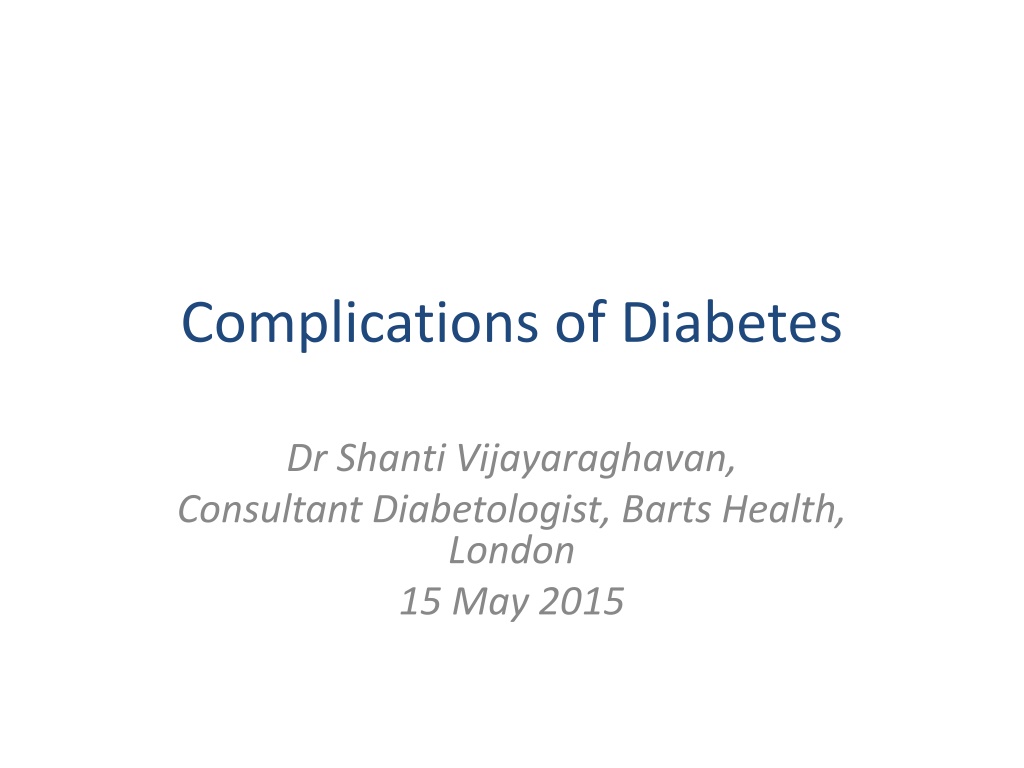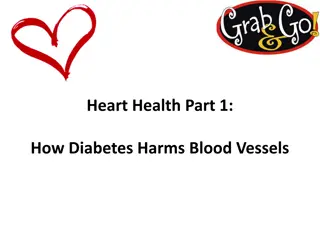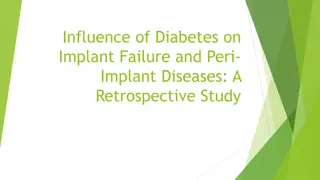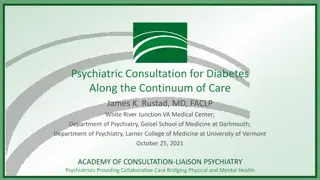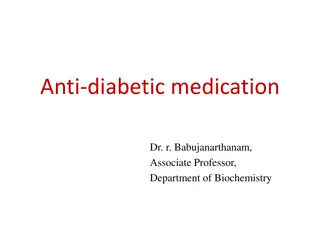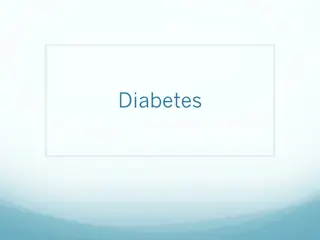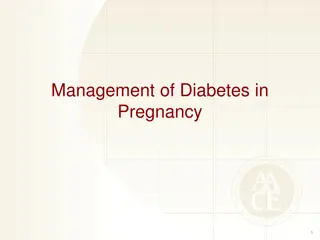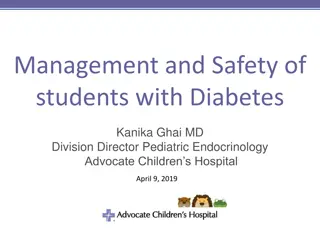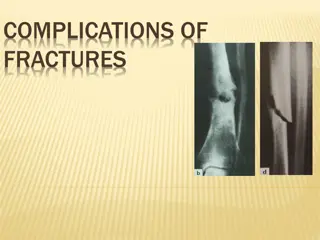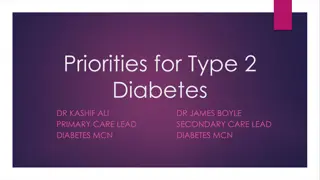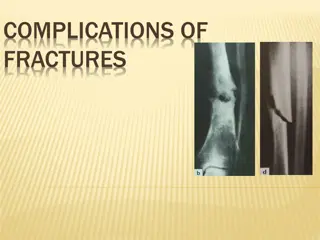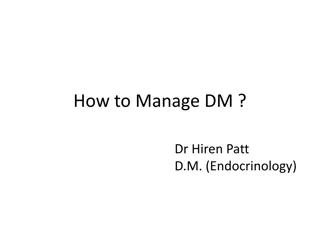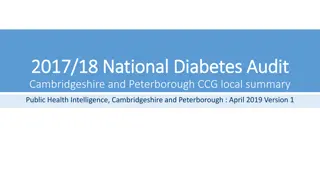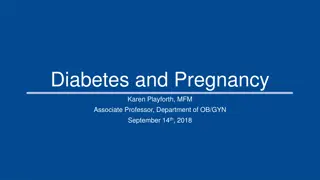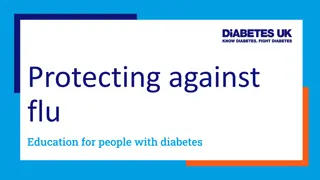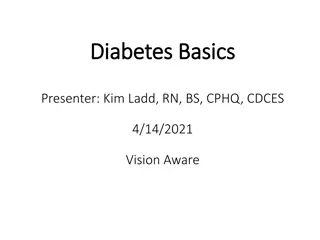Complications of Diabetes
"Explore acute and short-term complications of diabetes, including hypoglycemia and hyperglycemia. Learn about real-life cases and their management strategies. Discover the symptoms of hypoglycemia, common causes, and effective treatments to address this serious condition. Understand the importance of timely intervention and proper care in diabetic emergencies."
Download Presentation

Please find below an Image/Link to download the presentation.
The content on the website is provided AS IS for your information and personal use only. It may not be sold, licensed, or shared on other websites without obtaining consent from the author.If you encounter any issues during the download, it is possible that the publisher has removed the file from their server.
You are allowed to download the files provided on this website for personal or commercial use, subject to the condition that they are used lawfully. All files are the property of their respective owners.
The content on the website is provided AS IS for your information and personal use only. It may not be sold, licensed, or shared on other websites without obtaining consent from the author.
E N D
Presentation Transcript
Complications of Diabetes Dr Shanti Vijayaraghavan, Consultant Diabetologist, Barts Health, London 15 May 2015
Acute or Short-term Complications 1. Hypoglycaemia: low blood glucose level 2. Hyperglycaemia: Diabetic Ketoacidosis (DKA) Hyperosmolar Hyperglycaemic State (HHS)
CB, 32/F Primary school teacher, type 1 DM of 14 years duration (autoimmune) September 2014: Change of job - desk-based to more active job Started cycling to work Sensible diet and plenty of exercise BMI 23, on Novorapid insulin with each meal, and glargine insulin at night January 2015: Very erratic blood glucose control with frequent hypoglycaemia during the day (upto 10/day) No hypoglycaemia awareness March 2015: In a school meeting pre-lunch Sudden loss of conciousness with ? Seizure Taken to local A & E Blood glucose 1.5 mmol/l requiring IV glucose drips
AC, 82 M Type 2 diabetes for 30 years Son reports increasingly forgetful - ?dementia Often takes his medication and forgets to eat Family often find him in bed, drowsy, sweaty Blood glucose on a glucometer during such episodes 2-4mmol/l; responds to sugary drink or food Hba1c 32 mmol/l (5.1%) Medication changed
Hypoglycaemia (Hypo) Symptoms (hypo awareness): Feeling shaky, palpitations Sweating Hunger Tiredness Blurred vision Lack of concentration Headaches Mood changes Going pale. Many people may lack warning symptoms
What causes a Hypo? Excess insulin Delayed or missed meal, not enough carbs Unplanned physical activity, Drinking large quantities of alcohol or alcohol without food Infections Sometimes there just is no obvious cause.
Treatment If swallowing is intact and patient is conscious, 15 20g of fast-acting carbohydrate: Small glass of sugary (non-diet) drink At least three glucose tablets Five sweets, such as jelly babies Small carton of pure fruit juice Glucose gel. If unconscious: Glucagon Injection Call an ambulance: IV glucose
Diabetes & Driving Group 1 driver (cars and motorbikes) On insulin, inform the DVLA (in the UK) or DVA (Northern Ireland). Licence renewed every one, two, or three years. Any changes which occur between renewals (e.g. complications which might affect the ability to drive safely) should be reported when they happen. Drivers who are under medical supervision by a doctor do not need to notify if insulin is used for a temporary period only Group 1 driver on non-insulin medication for diabetes do not need to notify unless: Two episodes of severe hypoglycaemia within the last 12 months Impaired awareness of hypoglycaemia Disabling hypo whilst driving Other medical conditions e.g.: problems with vision (e.g. laser treatment/injections), circulation, or sensation (e.g. peripheral neuropathy).
Diabetes & Driving Group 2 driver (bus or lorry) Must inform the DVLA Insulin treatment: independent medical assessment every year. Should monitor blood glucose levels regularly and store results on a memory meter. Need to provide three months of continuous meter readings at assessment. Any changes to the condition or treatment should be reported Safe driving: On insulin, check blood glucose within two hours before getting behind the wheel and every two hours whilst driving. The DVLA advise that if blood glucose is 5mmol/l or less take carbohydrate before driving. If it is less than 4mmol/l do not drive. Diabetic driver jailed for impaling pedestrian A driver who failed to tell the DVLA that he had diabetes has been jailed for six months and banned from driving for three years leaving a pedestrian impaled on the railings after losing control of his car when his blood-sugar level plummeted.
Diabetic Ketoacidosis (DKA) Younger patient May be the first presentation of T1D usually, or in someone with pre-existing diabetes who omits their insulin Life threatening emergency May occur with inter-current illness Children: Puberty
Development of DKA Acidosis Ketones FFA Vomiting Lipolysis Catecholamines Cortisol Growth Hormone AVP Hypotension & Shock Dehydration Insulin Resistance/ Deficiency Osmotic Diuresis Cellular Glucose Uptake Glycosuria Hyperglycaemia
What are ketones? Ketones are produced as a by product of fatty acid synthesis in response to starvation 3 types Acetone Acetoacetate (acetoacetic acid) hydroxybutyrate ( hydroxybutyric acid)
Symptoms & Management Increased thirst, polyuria Weight loss Abdominal pain, vomiting Blurring of vision Ketone breath Tired, lethargic Collapse Treatment: monitored fluids and insulin, often requires an intensive care setting
HHS/ Hyperosmolar Hyperglycaemic State Typically older patient May be known to have T2 Diabetes or new presentation High mortality (15-20%) Diagnosis (JBDS HHS Guidance 2012): High osmolality >320 mosm/kg High blood glucose30 mmol/L Severely dehydrated and unwell May be associated with impaired mental state Associated infection, kidney disease, cardiovascular disease
Management The goals of treatment of HHS are to: normalise the osmolality gradually and safely replace fluid and electrolyte losses gradually and safely normalise blood glucose gradually and safely treat the underlying cause prevent arterial or venous thrombosis prevent other potential complications e.g. cerebral oedema/ central pontine myelosis prevent of foot ulceration
Long Term or Chronic Complications Diabetic Retinopathy: Commonest cause of blindness in the working age in UK Three types: Background retinopathy Proliferative retinopathy Maculopathy Other eye disease: premature cataracts, glaucoma
Diabetic Neuropathy Damage to the small blood vessels supplying the nerves Three main types of neuropathy: Sensory Motor Autonomic
Sensory Neuropathy Symptoms: Tingling and numbness Loss of ability to feel pain Loss of ability to detect changes in temperature Loss of coordination due to loss of position sense Burning or shooting pains these may be worse at night time.
Sensory Neuropathy Foot Ulcer Charcot Joint
Motor Neuropathy Symptoms: Muscle weakness, which could cause falls or problems with tasks such as fastening buttons. Muscle wasting, where muscle tissue is lost due to lack of activity Muscle twitching and cramps.
Autonomic Neuropathy Gastroparesis when food can t move through the digestive system efficiently. Symptoms of this can include bloating, constipation or diarrhoea Loss of bladder control, leading to incontinence Irregular heart beats Problems with sweating, either a reduced ability to sweat and intolerance to heat or sweating related to eating food (gustatory) Impotence (inability to keep an erection).
Cardiovascular Disease Risk of developing & dying from CHD is 2-5 times higher with diabetes Diabetes increases the risk of mortality or serious morbidity after a coronary event 1.5 to 3 fold Smoking increases the risk of cardiovascular death 4 fold in a person with diabetes Patients of South Asian descent have 40% higher risk of CHD
ABCDE... Secondary Prevention of CHD ( Lancet 2001) A Aspirin B Beta Blockers C Cholesterol-lowering drugs D Diet; Diabetes; Don t smoke E Exercise Primary prevention: Anti-hypertensive therapy: Aggressive lowering of BP lowers cardiovascular morbidity & mortality; reduce proteinuria Tight blood glucose management Lifestyle modification
Peripheral Vascular Disease Loss of peripheral circulation Intermittent Claudication Foot Ulcer Gangrene Amputation
Cerebrovascular Disease Common Manifestations: TIA/Transient Ischaemic Attacks Stroke Cerebrovascular dementia
Managing people with Chronic Kidney Disease Reduce cardiovascular risk: lifestyle changes Dietary advice: potassium, phosphate, calorie and salt intake Good blood sugar & BP management reduces progression Pharmacotherapy : Sodium Bicarbonate reduces metabolic acidosis Anti-platelet therapy to reduce CVD Refer Renal Physicians
CKD - Management Sodium Bicarbonate: Consider oral supplementation to manage metabolic acidosis Vitamin D: may be used to treat CKD mineral bone disorder Anti-platelet therapy : Offer to prevent secondary cardiovascular disease.
Risk & Progression Risk factors Cardiovascular disease Proteinuria Hypertension Acute Kidney Injury Diabetes Smoking African Caribbean, Asian origin Long term use of NSAIDs Untreated urinary outflow obstruction
The changing face of diabetic pregnancy in UK The Adult Obesity Time Bomb (One in 5 adults in UK are now obese) Type 2 diabetes epidemic The Childhood Obesity Time Bomb Multi-ethnicity in many health districts
Diabetes in pregnancy Pre-existing T1 or T2 DM Gestational Diabetes (GDM) Risk factor for GDM include: Obesity Family history of diabetes An unexplained stillbirth or neonatal death in a previous pregnancy, and/or a very large infant in a previous pregnancy (4.5kg / 10 pounds or over) Previous gestational diabetes before Family origin is South Asian, Black Caribbean or Middle Eastern.
Major problems arising from diabetes in pregnancy Increased risk of stillbirth, neonatal death Increased risk of major congenital malformations (pre-existing diabetes) 2 to 5 fold increase in risk Macrosomia (all types) shoulder dystocia etc Neonatal hypoglycaemia (all types)
Major congenital malformations associated with maternal diabetes Cardiac: Transposition of great vessels, ventricular septal defect, situs inversus, single ventricle, hypoplastic left ventricle CNS: Anencephaly, encephalocoele, meningomyelocele, Spina Bifida Renal: Agenesis, multicystic dysplasia Pulmonary: Hypoplasia Gastrointestinal: Anal/rectal atresia, small left colon
Confidential Enquiry into Maternal and Child Health (CEMACH); Diabetes Study Study of pregnancy in women with pre-existing diabetes 2002/03 Prevalence of type 2 diabetes linked to ethnicity and socio- economic status Stillbirth rate 26.8 per 1000 v 5.7 Perinatal Mortality Rate 31.8 per 1000 v 8.5 Major congenital abnormalities increased by x 2 No difference between Type 1 and Type 2 diabetes
Screening for foetal malformations In women with pre-existing diabetes: Detailed fetal ultrasound at 18 to 20 weeks to exclude congenital anomalies foetal cardiac anomaly scan
Pre-pregnancy preparation in type 2 diabetes Should include: Optimise Blood Glucose control (and remain on reliable contraception in interim) Start Folic Acid 5 mg od Stop lipid lowering drug therapy Change anti-hypertensive therapy to Methyl Dopa or Labetolol Review status of microvascular disease
The Diabetes Annual Review Examination Examine: Feet Peripheral Pulses Peripheral Nerves BP Eyes Blood tests: Hba1c blood glucose Renal Function Lipid Screen Urine Protein
